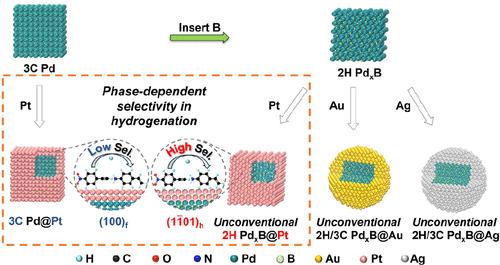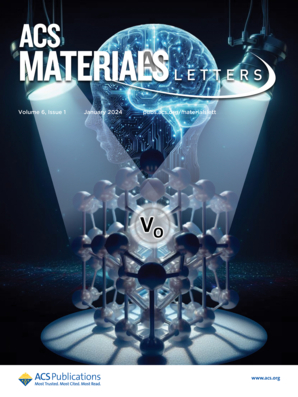非常规 2H 贵金属的外延生长和铂在加氢催化中的晶相选择性
IF 8.7
1区 化学
Q1 MATERIALS SCIENCE, MULTIDISCIPLINARY
引用次数: 0
摘要
晶体结构在调整贵金属纳米材料的物理化学特性方面发挥着重要作用。然而,合成非常规相贵金属纳米晶体,尤其是具有定义明确的切面的纳米晶体,仍然具有挑战性。在这里,我们通过在预先设计好的 2H PdxB 纳米种子上进行基于相位的外延生长,开发出了一系列具有新型六方紧密堆积(2H)相的贵金属壳,包括铂、金和银,从而得到了 2H PdxB@铂、2H/面心立方(ccc,或 3C)异相 PdxB@金和 PdxB@银核壳纳米结构。令人印象深刻的是,非常规的 2H 铂壳显示出较高的相纯度和清晰的 2H 面,这为研究晶体结构依赖性铂纳米催化剂的催化性能提供了一个极好的模型。值得注意的是,在 4-硝基苯乙炔的氢化过程中,2H PdxB@Pt 对 4-氨基苯乙烯具有极高的催化选择性(93%),优于传统的 3C Pd@Pt 和商用 Pt/C。这项工作为设计和合成非常规相金属纳米催化剂以及研究晶体结构依赖性催化行为提供了一种通用策略。本文章由计算机程序翻译,如有差异,请以英文原文为准。

Epitaxial Growth of Unconventional 2H Noble Metals and Crystal Phase-Dependent Selectivity of Pt in Hydrogenation Catalysis
Crystal structure plays an important role in tuning the physicochemical properties of noble metal nanomaterials. However, it remains challenging to synthesize unconventional-phase noble metal nanocrystals, particularly with well-defined facets. Here, we develop a series of noble metal shells, including Pt, Au, and Ag, with the novel hexagonal close-packed (2H) phase via a phase-based epitaxial growth on predesigned 2H PdxB nanoseeds, resulting in 2H PdxB@Pt, 2H/face-centered cubic (fcc, or 3C) heterophase PdxB@Au, and PdxB@Ag core–shell nanostructures. Impressively, the unconventional 2H Pt shells show high phase purity with well-defined 2H facets, which provide an excellent model to investigate the crystal structure-dependent catalytic properties of Pt nanocatalysts. Significantly, 2H PdxB@Pt exhibits a remarkably high catalytic selectivity (93%) toward 4-aminostyrene in the hydrogenation of 4-nitrophenylacetylene, outperforming conventional 3C Pd@Pt and commercial Pt/C. This work provides a general strategy to design and synthesize unconventional-phase metal nanocatalysts and study the crystal structure-dependent catalytic behaviors.
求助全文
通过发布文献求助,成功后即可免费获取论文全文。
去求助
来源期刊

ACS Materials Letters
MATERIALS SCIENCE, MULTIDISCIPLINARY-
CiteScore
14.60
自引率
3.50%
发文量
261
期刊介绍:
ACS Materials Letters is a journal that publishes high-quality and urgent papers at the forefront of fundamental and applied research in the field of materials science. It aims to bridge the gap between materials and other disciplines such as chemistry, engineering, and biology. The journal encourages multidisciplinary and innovative research that addresses global challenges. Papers submitted to ACS Materials Letters should clearly demonstrate the need for rapid disclosure of key results. The journal is interested in various areas including the design, synthesis, characterization, and evaluation of emerging materials, understanding the relationships between structure, property, and performance, as well as developing materials for applications in energy, environment, biomedical, electronics, and catalysis. The journal has a 2-year impact factor of 11.4 and is dedicated to publishing transformative materials research with fast processing times. The editors and staff of ACS Materials Letters actively participate in major scientific conferences and engage closely with readers and authors. The journal also maintains an active presence on social media to provide authors with greater visibility.
 求助内容:
求助内容: 应助结果提醒方式:
应助结果提醒方式:


